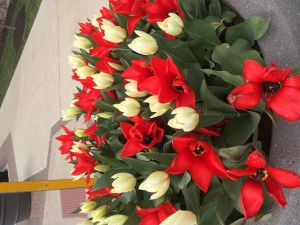



By: Paige Tetens, Monika Juzwiak, and Morgan McCabe (Discussion Section 12)
Physical Description
Tulips are flowers that grow from bulbs and bloom in the spring. The flower consists of two types of tepals (the outer parts of the flower – sepals and petals), sometimes varying in color.
Typically brightly colored, the tepals may have different colored blotches at the base. Most common colors found in tulips are red, yellow, pink and white.
Essay
The tulip flower has a marked presence on Livingston Campus in New Brunswick, New Jersey. Planted in early spring by the gardeners of Rutgers University, these flowers are a signal to the residents and passing students of this campus that the end of the academic year is drawing close. These flowers can be seen in large, organized clusters mainly outdoors in cement planters. The organization and uniformity of these arrangements is a testament to the stereotypically Dutch view on cleanliness and order. After the conversion to Protestantism, the Dutch were known to be an extraordinarily tidy people due to what was known as the “protestant work ethic”, where success and godliness were sought through diligent work. When the Dutch colonized the New World, they brought their views on order and the value of hard work with them–an influence which lingered.
Our interest in the tulip stemmed from our visit to the Amsterdam Flower Market where the sheer volume and diversity of tulips left quite an impression on us.
While tulips now grow in many different places around the world, they are primarily a symbol of Dutch culture. They are actually originally from Turkey and Persia! They were introduced to Europe by an Ottoman ambassador towards the end of the 16th century. The Netherlands marks 1594 as the date of the first flowering tulips in the country. Mere decades later, The Netherlands was struck by Tulipmania, where the demand for tulips was so high, you could trade things a complete bed, two tons of butter, or 1,000 pounds of cheese for a single bulb. In a rather interesting anecdote, a sailor was arrested for mistaking a valuable tulip bulb for a raw onion and consuming it. Now, tulips are rather common and The Netherlands produces about 3 billion bulbs a year. Chances are, if you see a tulip outside, it’s Dutch.
Today, one can buy tulip flowers with relative ease. However, since these are rarely bought for oneself, it is important to consider the symbolic significance of the plant’s color. Red, for example, signifies the “fire of love” that is felt by the giver for the recipient, whereas white can be used apologetically.
Bibliography
Upchurch, Michael. “How A Turkish Blossom Enflamed the Dutch Landscape.” The New York Times. The New York Times, 03 Mar. 2001. Web. 10 Apr. 2016.
Christenhusz, Maarten J. M., et al. “Tiptoe Through The Tulips – Cultural History, Molecular Phylogenetics And Classification Of Tulipa ( Liliaceae).” Botanical Journal Of The Linnean Society 172.3 (2013): 280-328. Academic Search Premier. Web. 10 Apr. 2016.
Curtis, Diana. “Plath’s TULIPS.” Explicator 64.3 (2006): 184-186. Academic Search Premier. Web. 10 Apr. 2016.
“Mackay, Charles, Memoirs of Extraordinary Popular Delusions and the Madness of Crowds: Library of Economics and Liberty.” Mackay, Charles, Memoirs of Extraordinary Popular Delusions and the Madness of Crowds: Library of Economics and Liberty. N.p., n.d. Web. 10 Apr. 2016.
